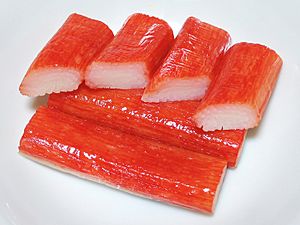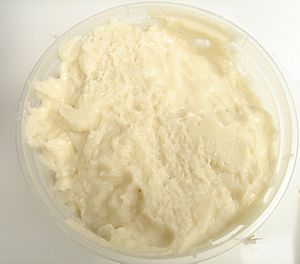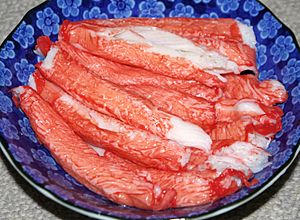Surimi facts for kids

Surimi (Japanese: 擂り身 / すり身, "ground meat") is a special paste made from fish or other types of meat. The word "surimi" can also mean many East Asian foods that use this paste as their main ingredient. It comes in different shapes, forms, and textures. People often use it to make foods that look and feel like lobster, crab, grilled Japanese eel, or shellfish.
The most common surimi product you might see in Western countries is imitation crab meat. This product is often called krab, imitation crab, or mock crab in the United States. In countries like the UK, it's known as seafood sticks, crab sticks, or fish sticks. Sometimes it's called seafood highlighter or seafood extender. In Britain, it's called seafood sticks to make sure it follows rules about honest advertising.
Contents
How Surimi Started
Fish pastes have been a popular food in East Asia for a very long time. In China, people use this paste to make fish balls and a thick soup called "Geng". This soup is common in Fujian cuisine. In Japan, surimi was first made around the year 1115 to create a food called kamaboko.
Alaska pollock is a fish found in the seas around Japan. It has a lot of protein, which made it very important for developing processed surimi. Before 1960, other popular surimi foods included satsumaage, chikuwa, and hanpen.
After World War 2, machines started being used to process surimi. However, it was always sold fresh. Freezing surimi used to make it spongy and less firm. Between 1945 and 1950, a lot of pollock was caught in Hokkaido, Japan. Scientists there looked for ways to use the extra fish meat.
A team led by K. Nishiya found that adding salt during processing stopped the spongy texture after freezing. They also started using salted surimi to make fish sausages. Later, in 1969, Nishitani Yōsuke discovered that adding sucrose (sugar) or other carbohydrates like sorbitol helped protect the fish protein when frozen. This kept the surimi firm.
Japan's new surimi technology in the early 1960s helped the industry grow a lot. In 1963, the Hokkaido government got a patent for this technology. Companies like Nippon Suisan and Maruha-Nichiro started freezing fish at sea in the mid-1960s. Surimi use in Japan peaked in 1975. After that, people started eating more beef and pork. Also, some lower-quality surimi products made people think less of surimi in general.
In 1976, a law called the Magnuson–Stevens Fishery Conservation and Management Act was passed in the United States. This led to the US working with Japanese fish processors in the surimi industry. Imitation crab products were created in Japan between 1973 and 1975. Even though they weren't super popular in Japan, they helped surimi become known around the world. Since the 1980s, new ways to use different types of fish for surimi were developed. The first surimi processing plant in the US was built in 1984 in Alaska. Canada built one in 1995, with help from Japanese experts.
In the early 1990s and late 2000s, the price of surimi went up a lot. This caused many small Japanese kamaboko companies to close. It was hard for them to afford the materials. Also, younger generations in Japan were eating kamaboko less often. As prices rose, the surimi industry looked for ways to waste less fish. A technique called the decanter method, developed in the mid-1990s, helped recover even more fish meat during processing.
Today, about two to three million tons of fish from around the world are used for surimi. That's about 2-3% of all fish caught globally. The United States and Japan are big producers of surimi. Thailand has also become an important producer, and China's role is growing. Many new countries have started making surimi, including Lithuania, Vietnam, Chile, the Faroe Islands, France, and Malaysia.
How Surimi is Made
First, lean meat from fish or land animals is separated or finely chopped. Then, the meat is rinsed many times to remove any unwanted smells. After rinsing, it is beaten and crushed to form a soft, jelly-like paste.
To get the right texture and taste for the final surimi product, different things are mixed into the paste. These can include starch, egg white, salt, vegetable oil, and sweeteners like sorbitol and sugar. Other ingredients like soy protein, seasonings, and special enzymes like transglutaminases or monosodium glutamate (MSG) might also be added.
If the surimi will be packaged and frozen, special food-grade ingredients called cryoprotectants are added. These act as preservatives while the meat paste is being mixed. Most of the time, surimi is processed right away into its final shape and cooked.
Fish Surimi
The paste made from fish is usually quite plain in taste. This means it needs to be flavored artificially. According to the United States Department of Agriculture, fish surimi is about 76% water, 15% protein, almost 7% carbohydrate, and less than 1% fat.
In North America and Europe, "surimi" often refers to fish-based products made using this process. In Japanese, a general term for fish-based surimi is "fish-puréed products" (gyoniku neri seihin). Whitefish are great for making surimi because they form a good gel. However, thanks to new technology, other fish, including dark meat fish, can also be used.
Some of the fish used to make surimi include:
- Alaska pollock
- Atlantic cod
- Big-head pennah croaker
- Bigeyes
- Golden threadfin bream
- Milkfish
- Pacific whiting
- Different types of shark
- Swordfish
- Tilapia
- Black bass (like Smallmouth bass and Largemouth bass)
Meat Surimi

While not as common in Japanese or Western stores, pork surimi (肉漿) is a popular product in many Chinese foods. Making pork surimi is similar to making fish surimi. However, leaner cuts of meat are used, and the rinsing step is skipped. Pork surimi is often made into pork balls (Chinese: gòngwán). When cooked, these balls feel like fish balls but are much firmer.
Pork surimi is also mixed with flour and water to make a special dumpling wrapper called "yànpí". This wrapper has the same firm and springy texture as cooked surimi.
Beef surimi can also be shaped into "beef balls". When beef surimi is mixed with chopped beef tendons, it forms "beef tendon balls". Both of these products are often used in Chinese hot pot dishes. They are also served in Vietnamese phở. Bakso, made from beef surimi, is a very popular food in Indonesia.
The surimi process is also used to make turkey products. It can be used for turkey burgers, turkey sausage, turkey pastrami, turkey franks, turkey loaf, and turkey salami.
How Surimi Gets Firm
The firmness of the fish paste happens when the protein called myosin changes when heated. The type of fish used is the most important thing that affects this process. Many fish that swim near the surface of the ocean have higher fat content. They don't have the right kind of myosin to become firm when heated, so they are not used for surimi.
Some fish, like the Pacific whiting, need extra ingredients to form firm surimi. These can include egg white or potato starch. In the past, some factories added bovine blood plasma to fish paste to help it get firm. Today, some makers might use a special enzyme called transglutaminase to make the surimi's texture better. It is against the rules, but some places in Asia illegally add borax to fish balls and surimi. This makes them extra bouncy and whiter.
Uses and Products

Surimi is a very useful ingredient for making different kinds of processed foods. It allows companies to create foods that taste and feel like more expensive products, such as lobster tail. But they can use a much cheaper material. Surimi is also an affordable source of protein.
In Asian cultures, surimi is often eaten as a food on its own. It is not usually used to pretend to be other foods. In Japan, fish cakes (kamaboko) and fish sausages are common. Other shaped fish products are also sold as cooked surimi.
In Chinese cuisine, fish surimi is often called "fish paste." It is used directly as a filling or made into balls. Balls made from lean beef and pork surimi are also common in Chinese cooking. Fried, steamed, and boiled surimi products are often found in Southeast Asian cuisine.
In Western countries, surimi products are usually imitation seafood. These include fake crab, abalone, shrimp, calamari, and scallop. Some companies also make surimi sausages, luncheon meats, hams, and burgers. Examples include Salmolux salmon burgers and SeaPak surimi ham, salami, and rolls. There's even a special way to make higher-quality proteins from fish, like making imitation steak from surimi. Surimi is also used to make kosher imitation shrimp and crabmeat, using only kosher fish like pollock. You might also find surimi salad, which is imitation crab meat mixed with mayonnaise and vegetables.
List of Foods Made from Surimi
- A-gei - a stuffed tofu dish
- Chikuwa - a Japanese grilled surimi product
- Crab stick - also known as imitation crab
- Kamaboko - shaped into loaves and steamed, served sliced
- Gyoniku soseji - fish sausages
- Hanpen - made from a mix of yam and surimi, cut into triangles
- Tsukune (Tsumire) - often put on skewers and cooked in different ways
- Fish ball/Bakso ikan
- Narutomaki - a type of kamaboko
- Yong tau foo - stuffed tofu
- Satsuma-age - deep-fried surimi patties
- Ngo hiang - wrapped in tofu skin and fried
- Pempek - shaped into logs and deep-fried
- Gefilte fish - formed into round patties and poached
See also
 In Spanish: Surimi para niños
In Spanish: Surimi para niños



